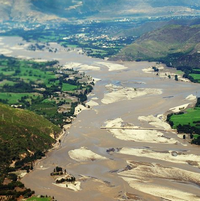Torrential monsoon rains since late July have flooded Pakistan's Swat Valley and portions of neighboring Afghanistan, killing nearly 2,000 people and displacing around 2 million. Relief efforts have included deployments of troops and helicopters by the Pakistan military, the NATO force in Afghanistan and, perhaps surprisingly, the nascent Afghan air corps. "Right now, the Afghan air force has four Mi-17 helicopters in Pakistan supporting that relief effort," said U.S. Air Force Brig. Gen. Michael Boera, head of Afghan air training.
The Afghan deployment underscores an encouraging trend in the nine-year-old war against the Taliban. On Aug. 11, top NATO commander Gen. David Petraeus announced that the Afghan army had reached its planned peak strength of 134,000 soldiers -- two months earlier than anticipated. Reacting to the news, U.S. Secretary of Defense Robert Gates said NATO might begin handing over security duties to Afghan forces as early as the spring of 2011.
The security handover would see Afghan forces increasingly taking the lead as foreign contingents begin a gradual withdrawal. The Dutch army removed its main ground forces from southern Afghanistan on Aug. 1. The Canadians are slated for a 2011 departure. U.S. and British troops might start leaving in the summer of 2011, though the pace of their drawdown will "depend on the conditions on the ground," Gates said. British planning currently calls for some U.K. combat troops remaining in Afghanistan as late as 2014.

